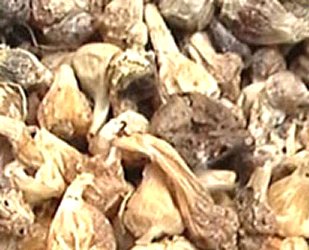Xie Bai

  | Xie Bai in TCM:Explore the properties of Xie Bai according to Chinese
Nutrition and Traditional Chinese Medicine (TCM):
Factoids:
English Name: bakeri, long-stamen onion bulb
Pharmacuetical Name: Bulbus Allii Macrostemonis
Properties: acrid, bitter, warm
Temperature: warm
Channels: LU, LI, ST
Flavors: bitter, pungent
Special Properties:
circulates qi, disperses cold, clears damp, resolves phlegm
Actions / Indications:
- Unblocks yang qi; dispels cold phlegm (chest bi:
damp-cold painful obstruction of the chest due to cold turbid phlegm
congealing and blocking yang qi; pain in chest, cold stagnation with
epigastric fullness, distension, abdominal pain;flank, upper back; dyspnea,
cough, wheeze, SOB, stifling sensation in chest; blood stasis in HT
channel with stabbing pain)
- Promotes movement of qi; Reduces stagnation (damp
stagnation in Large Intestine with dysenteric disorders, diarrhea or
dysentary with rectal tenesmus)
- (cc: qi deficiency)
- (cc: not for long term use with peptic ulcers)
Special Notes:
- Pharmacologically Xie Bai is an antibiotic that also inhibits clotting
time. Use with caution with Warfarin, Heparin, Enoxaparin, etc...
Disclaimer: In accordance with our terms of service, by using this web site you agree that none of the information found on this web site constitutes medical advice. You should always consult your doctor before trying any particular food or herbal remedy to treat disease.
Folk remedies presented on this site are designed to address specifc TCM diagnoses, and are not one-size-fits-all. If you would like to learn more about Traditional Chinese Medicine (TCM) and how it relates to Chinese Nutrition, you can book in a free call with a licensed professional. There is no obligation to purchase.
[CLICK HERE for your free INITIAL CONSULTATION] |

